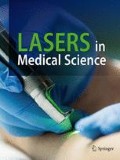The
objective of the study was to investigate the impact of
photobiomodulation (PBM) on the paretic upper limb in post-stroke
patients with spastic hemiparesis and to understand the potential of PBM
as a long-term non-invasive therapy for reducing the side effects
caused by spasticity in the hemiparetic upper limb after a stroke. This
is a double-blind randomized clinical trial constituted of 27
participants, being Control group (CG = 12 healthy individuals) and PBM
group (PBMG = 15 post-stroke individuals). In the CG, the baseline blood
lactate (BL) was evaluated, followed by the evaluation of the IC torque
of the biceps and triceps muscles, with the isokinetic dynamometer
associated with surface electromyography (EMG) and, subsequently, a new
measurement of BL. The PBMG received 10 sessions of treatment with PBM
(780 nm, Power: 100 mV, Power Density: 3.18 W/cm2, Energy: 4 J, Fluency: 127.4 J/cm2, Time: 40 s per point and 1.280 s total, Spot: 0.0314 cm2,
32 Points: 16 points (brachial biceps) and 16 points (brachial triceps)
applied with contact at 90°, Total Energy: 64 J), which in the
pre-treatment evaluation measured BL, the visual analogue scale (VAS) of
pain; torque and EMG of the same muscles in the IC, subsequently, a new
measurement of VAS and BL, and measurement of range of motion (ROM)
during the reaching movement. At the conclusion of the ten sessions, all
participants underwent a reassessment, wherein all tests originally
administered during the initial evaluation were repeated. Subsequently,
the data were analyzed using the Shapiro–Wilk normality test. For
related data, the paired t-test was used for normal distributions and
the Wilcoxon test for non-normal data. For unrelated data, the t test
was used for normal distributions and the Mann–Whitney test for
non-normal data. Muscle torque was higher for the CG, with a significant
difference (CGxPBMG = p < 0.0001). There was no significant
difference between the EMG values of the CG in relation to the Pre-PBM
phase and with the Post-PBM phase of the PBMG (p > 0.05). On the other hand, there was a 38% reduction in pain reported by hemiparetic patients (p = 0.0127)
and a decrease in BL in the PBMG. Post-PBM ROM increased by 46.1% in
the elbow extension of the paretic limb. In conclusion,
Photobiomodulation (PBM) demonstrated significant improvements in muscle
performance, reducing fatigue and pain levels, and enhancing range of
motion in post-stroke patients with spastic hemiparesis. These findings
support the potential integration of PBM into rehabilitation protocols,
but further research and clinical trials are needed to validate and
expand upon these promising outcomes.

No comments:
Post a Comment